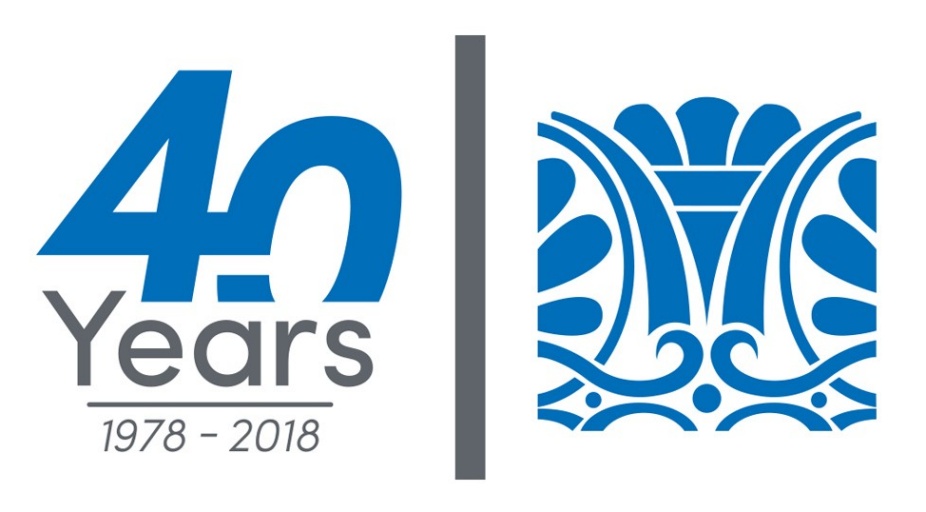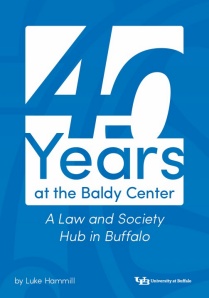Celebrating 40 Years

Monograph - 40 Years at The Baldy Center: A Law and Society Hub in Buffalo

In 2018, The Baldy Center celebrated its 40th Anniversary. To help commemorate this anniversary, The Baldy Center commissioned Luke Hammill, a Buffalo-based journalist and writer (and UB alumnus) to chronicle the Center’s history, from its foundation as a socio-legal research institute in 1978 to its development into a wide-ranging facilitator of multidisciplinary research, writing and events at UB and beyond.
We launched this book in Fall 2018 in tandem with the Law School's annual Mitchell Lecture, presented by Professor John Braithwaite of The Australian National University, on November 9. The talk was complemented November 10, by a day-long Baldy conference, "Tempering Power".
The anniversary monograph, 40 Years at The Baldy Center: A Law and Society Hub in Buffalo, is available via email, and print edition. To request the monograph be sent directly to you, give us a call at 716-645-2102, or send your request via email, baldycenter@buffalo.edu
Related Links
EXCERPT: 40 Years at the Baldy Center: A Law and Society Hub in Buffalo
The Baldy Center for Law and Social Policy might not exist if the University at Buffalo School of Law hadn’t made the audacious decision at the dawn of the 1970s to hire as its dean a man who was not a lawyer.
The late Richard D. “Red” Schwartz, a sociologist, was appointed in 1970 and began as dean at the UB law school the next year. In an interview taped in 2005, 12 years before he died last year at 92 years old, Schwartz recalled that he was the first-ever dean of an American law school to lack a Juris Doctor degree, save for one non-lawyer who had led Yale on an interim basis in an earlier decade.
Schwartz’s arrival and acceptance at UB was an example of the law school’s “Buffalo Model” in action, an institutional philosophy that encouraged interdisciplinary research exploring how the law actually interacted with the society around it.
Such research was at the core of the Law and Society Association, which had been founded in 1964 and sought to knock down the figurative walls law had built around itself. Schwartz was one of the Association’s founders and served as the first editor of its journal, the Law & Society Review.
Buffalo has played a crucial – and often overlooked – role in the Law and Society movement, from its early days to the current era. And that role has a lasting legacy at UB that continues to evolve today at the Baldy Center, which this year celebrates its 40th anniversary.
A serendipitous combination of events, including the hiring of Schwartz, made the Center possible, and since then, it has taken advantage of the opportunity, making its mark in the sociolegal world through research, education, conferences and publications.
But why’s it called the Baldy Center?
Shortly after Schwartz arrived on campus, UB learned it would soon be the likely recipient of a generous bequest from a man named Christopher Baldy, a well known Buffalo attorney who had died in 1959 at the age of 73.
Baldy was a 1910 graduate of the Buffalo School of Law, in the days when UB was the private University of Buffalo. In 1911, he joined the firm then known as Kenefick, Cooke, Mitchell & Bass as a law clerk, eventually becoming a partner and specializing in tax and corporation law. Today, the firm is Phillips Lytle LLP.
Baldy, a bachelor, became wealthy, and when he died, he was generous with his money toward his alma mater. His estate was initially valued at more than $1.4 million. In his will, he left relatively small amounts to his church, the Erie County Bar Association, his Masonic lodge and his two sisters-in-law. Nearly all the rest went to his three brothers, and when they died, whatever was left over was to be given to UB for a scholastic building or residence hall.
By the early 1970s, the amount in the fund for UB had grown to somewhere between $1.5 million and $2 million, according to a university memo from that period, and the last surviving Baldy brother was nearing the end of his life.
UB was about to finally get the money, but circumstances had significantly changed since Baldy died.
UB had become a public university and a part of the State University of New York, which at the time was spending generously on the construction of new buildings at its campuses, including the new North Campus that was then being built in Amherst.
University and law school officials felt that the Baldy money would be better used for an academic program and were able to convince a judge to allow it to fund research on one of Schwartz’s favorite subjects: the intersection of law and social policy. In return, a new building next to the law school (which had already been named for John Lord O’Brian) was named after Baldy.
Under the deanship of Thomas Headrick, the research program was eventually formalized in 1978 as the Baldy Center, and it has been on the fifth floor of O’Brian Hall ever since.
“I’m very proud to have had some small part in the development of The Baldy Center,” Schwartz said in the interview he recorded late in his life.